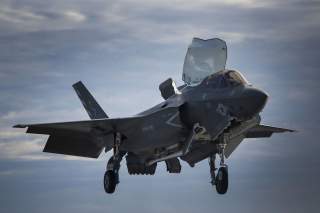America and Its Allies Just Flew F-35s and Big B-1 Bombers Near North Korea
Get the hint, Kim.
The United States, the Republic of Korea and Japan have conducted yet another combined airpower exercise over the Korean peninsula in response to North Korea’s latest provocations.
Coming three days after Pyongyang’s September 14 intermediate range ballistic missile (IRBM) test that overflew the Japanese home islands, the United States Air Force, United States Marine Corps as well the Japan Air Self-Defense Force and Republic of Korea Air Force conducted what the U.S. Pacific Command calls a “sequenced bilateral show of force” on Sept. 17.
The exercise included a pair of Rockwell International B-1B Lancer strategic bombers flying out of Andersen Air Force Base on Guam. The bombers were joined by a quartet of U.S. Marine Corps Lockheed Martin F-35B Lightning II short takeoff/vertical landing (STOVL) stealth fighters based out of Marine Corps Air Station Iwakuni in Japan. Four Republic of Korea Air Force (ROKAF) Boeing F-15K Slam Eagle strike fighters and four Japan Air Self-Defense Force Mitsubishi F-2 strike fighters joined the American aircraft for the mission.
“During the mission, U.S. and ROKAF aircraft flew across the Korean Peninsula and practiced their attack capabilities by releasing live weapons at the Pilsung Range training area,” reads a statement from the U.S. Pacific Command.
“The F- 35Bs, B-1B bombers and Koku Jieitai fighters conducted formation training as they flew together over waters near Kyushu, Japan.”
The U.S. Pacific Command is careful in its wording of how it describes the exercise.
The Japanese F-2 fighters—a derivative of the ubiquitous Lockheed Martin F-16C Fighting Falcon—flew one of leg of the mission without the participation of the South Korean Slam Eagles. The American forces—who flew a single large mission—also conducted live fire drills with the ROKAF as part of their sortie, but without the presence of the Japanese. At no point did the South Koreans and Japanese themselves work together as part of an overall package of friendly aircraft.
The problem at the end of the day is that while the United States is allied to both Japan and South Korea, the two Asian nations are not themselves allied to each other. Indeed, much of the animosity between Japan and South Korea goes back to the Japanese Empire’s brutal occupation of the Korean peninsula from 1910 to 1945. While relations between the two Asian nations have much improved over the years, there are still underlying tensions over unresolved issues stemming from that dark period in Asia’s past.
Dave Majumdar is the defense editor for The National Interest. You can follow him on Twitter: @Davemajumdar.

